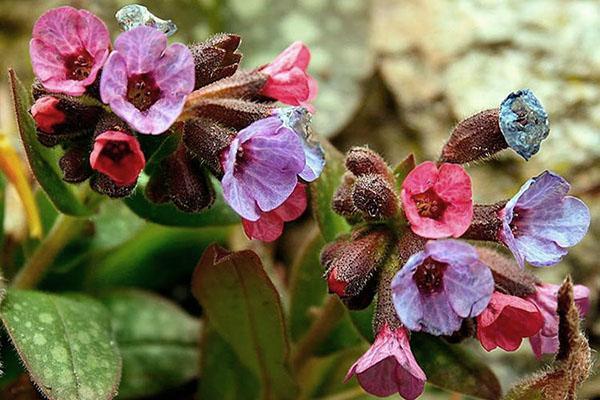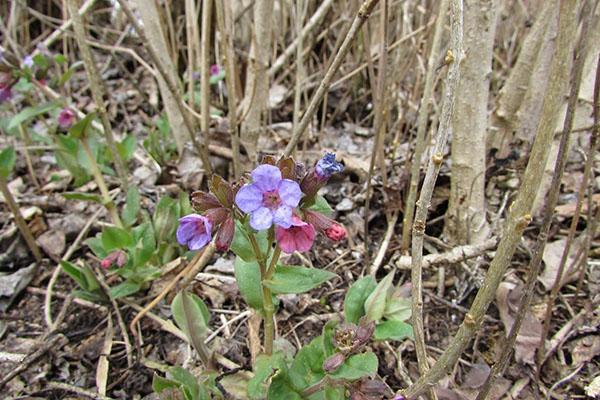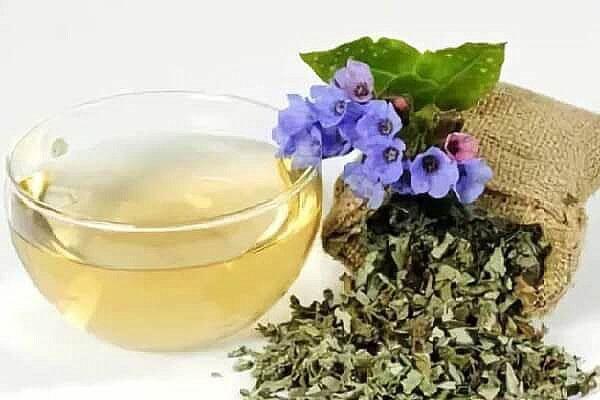We study the healing properties of lungwort
 A herbaceous plant with a mellifluous name lungwort is found in coniferous and deciduous forests, in glades, in shallow ravines, along plantings. The healing properties of lungwort, as well as its decorative characteristics, were made to cultivate this flower. Surprisingly, flowers of different shades are combined on one stem - pink, blue, red, purple, white. This is explained by the presence of plant pigments of anthocyanins, which react differently to the acidity of the petals. These unique pigments provide the culture with high medicinal properties.
A herbaceous plant with a mellifluous name lungwort is found in coniferous and deciduous forests, in glades, in shallow ravines, along plantings. The healing properties of lungwort, as well as its decorative characteristics, were made to cultivate this flower. Surprisingly, flowers of different shades are combined on one stem - pink, blue, red, purple, white. This is explained by the presence of plant pigments of anthocyanins, which react differently to the acidity of the petals. These unique pigments provide the culture with high medicinal properties.
Medunitsa - description, composition, characteristics

It is a perennial plant that grows to a height of only 30 cm. The culture belongs to the borage family, has an erect stem and large lanceolate leaves. The flowers are separate, outwardly similar to small bells. The root is large, thick, forms tubers. The lungwort ripens a fruit that looks like a nut. The grass does not tolerate heat, therefore it prefers to grow in the shade of tall trees or bushes. Read also about apple lungwort!
The chemical composition of lungwort is extensive:
- anthocyanins are pigment substances that have a bactericidal effect, in nature they give color to different parts of plants - leaves, flowers, fruits;
- flavonoids - organic compounds with high antioxidant activity, which helps people in the fight against bad mood;
- tannins - astringent substances of natural origin, suppress the reproduction and development of pathogenic microflora, on the skin and mucous membranes, in the intestines;
- saponins - complex organic compounds endowed with the property of foaming, in the human body enhance the processes of mucus formation and salivation;
- allantoin is a natural oxidation product that has anesthetic and anti-inflammatory effects;
- ascorbic acid - commonly known as vitamin C, which increases resistance to infections, viruses, diseases;
- silicic acid - a plant component that promotes the elimination of toxins and toxins, normalizing the function of the gastrointestinal tract;
- beta-carotene - the most important of the carotenes, is converted into vitamin A under the action of liver enzymes;
- vitamins - simple organic compounds that enter the body with food, participating in important processes in a living body;
- microelements and macroelements - a group of mineral substances that are of high vital importance for a person.
How is lungwort useful for health
 The healing properties of lungwort are manifested in diseases of the upper respiratory system - tracheitis, bronchitis, pneumonia. The herb helps to recover even in the most severe and advanced cases of hemoptysis. The lungwort is especially useful if you suffer from a dry, unproductive cough, accompanied by a hoarse voice, hoarseness.In just a few days of its application, sputum is easily coughing up and well excreted from the body.
The healing properties of lungwort are manifested in diseases of the upper respiratory system - tracheitis, bronchitis, pneumonia. The herb helps to recover even in the most severe and advanced cases of hemoptysis. The lungwort is especially useful if you suffer from a dry, unproductive cough, accompanied by a hoarse voice, hoarseness.In just a few days of its application, sputum is easily coughing up and well excreted from the body.
Medunitsa medicinal is used for disorders of the genitourinary system - cystitis, urinary incontinence, nephritis, urethritis, stones and sand in the ducts of the liver, kidneys, biliary tract. The plant quickly relieves inflammation, reduces pain and cramps.
The culture is distinguished by its ability to heal. The anthocyanins contained in it stop internal and external bleeding, promotes tissue regeneration, and weaken pain symptoms.
Thanks to bioflavonoids, which are part of the lungwort in high concentration, the plant has a positive effect on the nervous system. By brewing leaves and flowers every day instead of tea, you can deal with stress and depression without medication.
The plant has a beneficial effect on the function of hematopoiesis, stimulates the production of red blood cells of erythrocytes. Because of this ability, lungwort is recommended for the prevention and treatment of anemia, as an independent component, or as part of medicinal preparations.
 Due to its high iodine content, the herb is beneficial for the thyroid gland and is used to treat goiter. It is with a lack of this element that many disorders and pathologies of the organ arise, dysfunction occurs, and the production of necessary hormones decreases.
Due to its high iodine content, the herb is beneficial for the thyroid gland and is used to treat goiter. It is with a lack of this element that many disorders and pathologies of the organ arise, dysfunction occurs, and the production of necessary hormones decreases.
The plant is widely used for cosmetic purposes - it improves the quality of the skin and nails, reduces the harmful effects of ultraviolet radiation, and prevents premature aging. Lungwort for hair is used when it falls out heavily, splits, becomes weakened and lifeless.
The healing properties of lungwort
 In folk medicine, the herb lungwort has long established itself from an extremely positive side. It is safe for children and adults, the elderly, and is allowed for use during pregnancy and lactation.
In folk medicine, the herb lungwort has long established itself from an extremely positive side. It is safe for children and adults, the elderly, and is allowed for use during pregnancy and lactation.
 Lungwort - useful properties and uses:
Lungwort - useful properties and uses:
- Expectorant. The plant is widely used internally in the treatment of various diseases of the pulmonary-bronchial tree, for example, pneumonia, asthma, tuberculosis.
- Antimicrobial. Infusions and decoctions based on lungwort are used for skin diseases, tissue damage by bacterial infections. They make baths with it, lubricate painful places, apply lotions.
- Pain reliever. The herb effectively relieves the condition in case of exacerbation of gastric ulcer or duodenal ulcer. As an auxiliary measure, it helps with gastritis, pancreatitis, duodenitis.
- Spasmolytic. Culture promotes relaxation of the smooth muscles of the internal organs. It is often used for colic, heart failure.
- Sedative. Tea from lungwort soothes the nervous system, relieves stress and irritation, helps to fight stress, cures migraines, relieves headaches.
- Anti-inflammatory. The infusion of lungwort inside removes inflammation when diseases of the gastrointestinal tract. When applied externally, it relieves swelling, itching, redness.
- Antiseptic. Decoction of dried leaves and flowers of honeycomb gargle with sore throat, laryngitis, pharyngitis. A warm liquid is kept in the mouth if there is inflammation of the mucous membranes or gums with gingivitis, stomatitis, periodontitis.
- Diuretic. The lungwort has a mild diuretic effect. With constant use, it helps wash out sand, destroys stones, and evens out the acid-base balance.
- Hematopoietic. The stems and leaves of the plant contain all the necessary complex of trace elements necessary for the full and timely production of erythrocytes. The complex contains iron, copper, manganese, iodine, selenium, silicon and potassium.
- Immunomodulatory. The high content of trace elements such as iodine and silicon, antioxidants, allows the use of lungwort to strengthen the immune system.It increases the body's resistance and resistance to various kinds of infections, improves defenses and mechanisms, and is used to prevent colds, respiratory viral diseases.
Can lungwort harm people
 Medicines from lungwort do not have strict restrictions on their use. Very young children and adolescents, adults, and the elderly are successfully treated with medicinal herbs. If you cannot collect the herb yourself, find the plant from traditional healers or local herbalists, then you can buy it in bulk or in the form of filter bags at the pharmacy. It is permissible for children to use lungwort from the age of 3 years. Outwardly, lungwort is allowed during pregnancy, it is better not to take it inside during this period.
Medicines from lungwort do not have strict restrictions on their use. Very young children and adolescents, adults, and the elderly are successfully treated with medicinal herbs. If you cannot collect the herb yourself, find the plant from traditional healers or local herbalists, then you can buy it in bulk or in the form of filter bags at the pharmacy. It is permissible for children to use lungwort from the age of 3 years. Outwardly, lungwort is allowed during pregnancy, it is better not to take it inside during this period.
How to use medunica medicinal
 The healing properties of lungwort are concentrated in the ground part of the plant - leaves and flowers. They are carefully cut off during flowering along with the stem, dried, tied in bunches. The dried herb is ground, decoctions, infusions are prepared on the basis of the finished raw materials, brewed medicinal tea... Lungwort goes well with many other medicinal plants, so it is often included in medicinal herbs.
The healing properties of lungwort are concentrated in the ground part of the plant - leaves and flowers. They are carefully cut off during flowering along with the stem, dried, tied in bunches. The dried herb is ground, decoctions, infusions are prepared on the basis of the finished raw materials, brewed medicinal tea... Lungwort goes well with many other medicinal plants, so it is often included in medicinal herbs.
In England and France, fresh flowers and leaves of lungwort are used as edible decor in restaurant dishes and desserts.
Popular recipes with lungwort:
- Broth. For half a liter of water, you need a handful of dry crushed grass. The liquid is brought to a boil, boiled for 15 minutes. When the liquid cools down, filter it and drink half a glass twice a day - in the morning and in the evening after meals.
- Infusion. A tablespoon of dried raw materials is poured with a glass of boiling water. The liquid should be infused for 2 hours, then it is passed through cheesecloth. The resulting infusion is used for its intended purpose: internally - for one day, in three doses, or externally - for rinsing, rinsing, lotions, compresses, and so on.
- Tea. Fresh or dry parts of the plant (stems, leaves, flowers) are useful to brew and drink instead of traditional tea or coffee. The healing properties of lungwort are a good prevention of many diseases for children and adults.
- Alcoholic infusion. The third part of the selected glass container is filled with fresh grass, if a dried mixture is taken, then a quarter. The rest of the volume is topped up with high-quality vodka or alcohol diluted up to 40 °. The liquid is infused in a dark place for 2 weeks. The tincture is taken one teaspoon 3 times a day half an hour before meals. The course of treatment is 1 month.
Application of fresh lungwort
 The cut grass can be used immediately without waiting for it to dry. Leaves and flowers are finely chopped, turning into gruel. The prepared mass is applied to non-healing ulcers, deep and shallow cuts, used for burns and frostbite. The tool is able to get rid of corns and corns, neglected or recently appeared. The juice and pulp of lungwort are added to home cosmetics - masks for the face and scalp.
The cut grass can be used immediately without waiting for it to dry. Leaves and flowers are finely chopped, turning into gruel. The prepared mass is applied to non-healing ulcers, deep and shallow cuts, used for burns and frostbite. The tool is able to get rid of corns and corns, neglected or recently appeared. The juice and pulp of lungwort are added to home cosmetics - masks for the face and scalp.
It is popular and effective to use lungwort in a hike for quick and high-quality wound healing.
 Rules for the use of lungwort in field conditions (briefly):
Rules for the use of lungwort in field conditions (briefly):
- small scratches are washed and treated with plant juice, which is squeezed out of several leaves;
- when bleeding, a gruel of finely chopped green parts of the plant should be applied, then the blood will stop much faster;
- if suppuration has occurred, then a bandage with lungwort pulp should be applied, the bandage should be changed as it becomes dirty several times a day;
- with bites insects make lotions with juice or concentrated infusion of lungwort;
- if bitten by a bee, then a compress from a gruel of leaves and flowers will help relieve inflammation and swelling.
 Discontinue external use when improvements are clearly visible, ulcers and wounds begin to heal, inflammation and redness disappear, pain and itching subside.
Discontinue external use when improvements are clearly visible, ulcers and wounds begin to heal, inflammation and redness disappear, pain and itching subside.
Treatment with herbs inside does not accept haste, the course is usually one or two months, depending on the results achieved. Using the beneficial properties of lungwort, contraindications are also taken into account. The plant is prohibited in case of individual intolerance, the development of an allergic reaction.